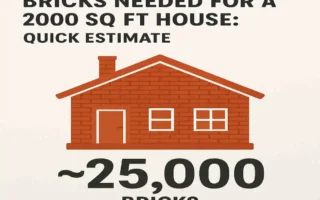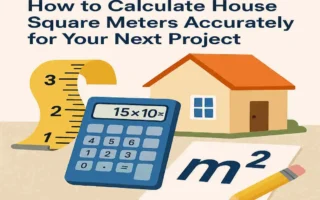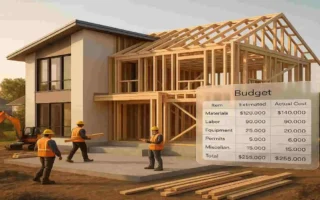Building a house is an exciting yet complex process, and one of the most critical steps is estimating the materials you’ll need—especially bricks. Whether you’re building a cozy 2-bedroom home or a sprawling 5-bedroom house, understanding how many bricks it takes to build a house is essential for proper planning, budgeting, and avoiding costly mistakes.
Why Brick Estimation Matters in Construction

The Role of Bricks in Construction
Bricks play a vital role in the construction of a house. They provide structural integrity, ensuring that your home is strong and durable. But bricks aren’t just about strength; they also contribute to the aesthetic appeal of your house. The right brick choice can enhance the overall look and feel of your home, making it more attractive and inviting.
Moreover, bricks have a significant impact on the cost of your construction project. The number of bricks you need directly affects the overall budget, so it’s essential to estimate accurately to avoid overspending.
Challenges of Overestimating or Underestimating Bricks
Estimating the number of bricks required for your house is not a task to be taken lightly. Overestimating can lead to material wastage and increased costs, while underestimating can cause delays and logistical issues during construction.
If you order too many bricks, you’ll end up with a surplus that you may not be able to use. This not only wastes resources but also adds to your expenses. On the other hand, if you don’t order enough bricks, you’ll face delays as you wait for additional deliveries. This can throw off your entire construction timeline and cause frustration.
To avoid these challenges, it’s crucial to approach brick estimation systematically. By following a step-by-step process and considering all the relevant factors, you can ensure that you order the right number of bricks for your project.
Factors That Affect the Number of Bricks Needed
Several factors come into play when determining how many bricks you’ll need for your house. Let’s explore these factors in detail:
Size of the House
The size of your house is one of the primary factors that affect brick requirements. Larger houses naturally require more bricks than smaller ones. To give you a better idea, let’s consider some examples:
- A small 2-bedroom house (around 1200 sq. ft.) will typically need fewer bricks compared to a larger home.
- A medium-sized 3-bedroom house (around 1800 sq. ft.) will require more bricks than a small house but less than a large one.
- A large 5-bedroom house (around 3000 sq. ft.) will have the highest brick demand among these examples.
As you can see, the dimensions of your house play a significant role in determining the number of bricks you’ll need. Keep this in mind as you plan your construction project.
Brick Type and Size
The type and size of the bricks you choose also impact the total number required. Common brick sizes include:
- Standard size: 2 1/4″ x 3 5/8″ x 8″
- Modular size: 2 1/4″ x 3 5/8″ x 7 5/8″
The size of the bricks you select will affect the overall count. Larger bricks will cover more area, requiring fewer units, while smaller bricks will need more to cover the same space.
Additionally, the type of brick you choose can influence the quantity needed. Clay bricks, concrete bricks, and other types have different dimensions and properties, which can impact the final count.
Wall Thickness and Design
The thickness and design of your walls also play a role in brick estimation. Single-wall construction typically requires fewer bricks than cavity walls, which have an air gap between two layers of brick.
Moreover, special designs like curved walls or decorative patterns can increase the number of bricks needed. These unique features may require custom-cut bricks or additional units to achieve the desired look.
When planning your house, consider the wall thickness and design elements to ensure accurate brick estimation.
Mortar Joints and Gaps
Don’t forget about the mortar joints and gaps between bricks! The thickness of the mortar used to hold the bricks together affects the total number of bricks required. Thicker mortar joints mean that fewer bricks will fit in a given area.
To accurately estimate your brick needs, you’ll need to factor in the mortar thickness and gaps between bricks. We’ll cover this in more detail in the step-by-step calculation guide later in this article.
Openings in the Structure
Finally, consider the openings in your house’s structure, such as windows, doors, and other cutouts. These openings will reduce the total brick count, as you won’t need bricks to fill these spaces.
When calculating your brick requirements, be sure to subtract the area of these openings from the total wall area. We’ll walk you through this process in the next section.
How to Calculate the Number of Bricks Required (Step-by-Step Guide)
Now that we’ve covered the factors that affect brick estimation, let’s dive into the step-by-step process of calculating the number of bricks you’ll need for your house.
Calculate the Wall Area
The first step in estimating your brick needs is to determine the total wall area of your house. To do this, you’ll need to measure the length and height of each wall, both internally and externally.
For example, if you have a wall that is 20 feet long and 8 feet high, the area of that wall would be:
Wall Area = Length x Height Wall Area = 20 ft x 8 ft Wall Area = 160 sq. ft.
Repeat this process for all the walls in your house, adding up the areas to get the total wall area.
Subtract Openings
Next, you’ll need to subtract the area of any openings in your walls, such as windows and doors. Measure the length and height of each opening and calculate its area using the same formula as before.
For example, if you have a window that is 3 feet wide and 4 feet tall, the area of that window would be:
Window Area = Length x Height Window Area = 3 ft x 4 ft Window Area = 12 sq. ft.
Subtract the total area of all openings from the total wall area to get the net wall area that needs to be covered with bricks.
Determine the Brick Area
Now, it’s time to determine the area covered by a single brick, including the mortar gap. The formula for this is:
Brick Area = (Length of Brick + Mortar Gap) x (Height of Brick + Mortar Gap)
Let’s use a common brick size of 2 1/4″ x 3 5/8″ x 8″ with a 3/8″ mortar gap as an example:
Brick Area = (2.25″ + 0.375″) x (3.625″ + 0.375″) Brick Area = 2.625″ x 4″ Brick Area = 10.5 sq. in.
Convert the brick area from square inches to square feet by dividing by 144:
Brick Area = 10.5 sq. in. ÷ 144 Brick Area = 0.0729 sq. ft.
Step 4: Estimate the Total Bricks Needed
With the net wall area and brick area calculated, you can now estimate the total number of bricks required. Divide the net wall area by the brick area:
Total Bricks = Net Wall Area ÷ Brick Area
Using our previous example of a 160 sq. ft. wall with a 12 sq. ft. window opening and a brick area of 0.0729 sq. ft.:
Net Wall Area = 160 sq. ft. – 12 sq. ft. Net Wall Area = 148 sq. ft.
Total Bricks = 148 sq. ft. ÷ 0.0729 sq. ft. Total Bricks = 2,030 bricks
To account for wastage and cutting, add a 5-10% buffer to the total brick count. For our example, let’s add a 7.5% buffer:
Total Bricks with Buffer = 2,030 bricks x 1.075 Total Bricks with Buffer = 2,182 bricks
Step 5: Consider Special Cases
If your house design includes special cases like curved walls, decorative patterns, or complex designs, you may need to adjust your brick estimation accordingly. These unique features can require custom-cut bricks or additional units to achieve the desired look.
Consult with your architect or contractor to determine the best approach for estimating bricks for these special cases.
To help you visualize the brick estimation process, here’s a table summarizing the calculations for our example:
| Step | Calculation | Result |
|---|---|---|
| 1 | Wall Area = Length x Height | 160 sq. ft. |
| 2 | Net Wall Area = Wall Area – Openings | 148 sq. ft. |
| 3 | Brick Area = (Length + Mortar Gap) x (Height + Mortar Gap) | 0.0729 sq. ft. |
| 4 | Total Bricks = Net Wall Area ÷ Brick Area | 2,030 bricks |
| 4 | Total Bricks with Buffer = Total Bricks x 1.075 | 2,182 bricks |
By following these steps and considering the factors we discussed earlier, you can accurately estimate the number of bricks needed for your house.
Real-Life Examples of Brick Requirements for Different House Sizes
To give you a better idea of how brick estimation works in practice, let’s look at some real-life examples of brick requirements for different house sizes.
Small 2-Bedroom House (1200 sq. ft.)
A small 2-bedroom house with a total wall area of approximately 1200 sq. ft. and standard openings might require around 15,000 to 18,000 bricks, depending on the specific design and brick size used.
Medium 3-Bedroom House (1800 sq. ft.)
A medium-sized 3-bedroom house with a total wall area of approximately 1800 sq. ft. and typical openings could need between 22,000 to 26,000 bricks, considering factors like wall thickness and brick type.
Large 5-Bedroom House (3000 sq. ft.)
A large 5-bedroom house with a total wall area of approximately 3000 sq. ft. and multiple openings might require anywhere from 35,000 to 42,000 bricks, depending on the complexity of the design and the chosen brick size.
Keep in mind that these are rough estimates and can vary based on the specific details of your house. Always consult with professionals and use the step-by-step guide provided earlier to get a more accurate brick count for your project.
Tips for Accurate Brick Estimation
Now that you understand how to calculate your brick needs, let’s explore some tips to ensure your estimation is as accurate as possible.
Use Online Brick Calculators
Online brick calculators can be a helpful tool in estimating your brick requirements. These calculators take into account various factors like wall area, openings, and brick size to provide you with an estimated brick count.
While online calculators can be useful, keep in mind that they may not account for all the unique aspects of your project. Use them as a starting point and adjust the results based on your specific needs.
Consult with Professionals
For the most accurate brick estimation, it’s always best to consult with professionals. Architects and contractors have the experience and knowledge to assess your project and provide a precise brick count.
Working with professionals can help you avoid common mistakes and ensure that your brick estimation is spot-on. They can also offer valuable insights and recommendations based on their expertise.
Order Extra Bricks
When ordering bricks for your project, it’s wise to order a buffer of extra bricks. This helps account for any wastage, breakage, or future repairs that may be needed.
A general rule of thumb is to order 5-10% more bricks than your estimated count. This way, you’ll have a safety net to cover any unexpected issues that may arise during construction.
Consider Local Factors
Don’t forget to consider local factors when estimating your brick needs. Climate, availability of bricks, and construction regulations in your area can all impact your brick requirements.
For example, if you live in an area with harsh weather conditions, you may need to use a specific type of brick that can withstand the elements. Similarly, local building codes may dictate certain brick sizes or types that you must use.
By taking these local factors into account, you can ensure that your brick estimation is tailored to your specific location and circumstances.
Cost Considerations: How Much Do Bricks Cost?

Now that you have a good understanding of how to estimate your brick needs, let’s talk about the cost considerations involved in purchasing bricks for your house.
Breakdown of Brick Costs
The cost of bricks can vary depending on several factors, including the type and quality of the bricks, the quantity you order, and any additional costs for transportation and storage.
Here’s a breakdown of the typical costs associated with purchasing bricks:
- Cost per brick: The price per brick can range from $0.30 to $1.50 or more, depending on the type and quality of the brick. Clay bricks tend to be more expensive than concrete bricks, while specialty or decorative bricks can cost even more.
- Bulk discounts: Many suppliers offer bulk discounts for larger orders. If you’re building a bigger house, you may be able to save money by ordering bricks in larger quantities.
- Transportation and storage: Depending on your location and the supplier, you may need to factor in additional costs for transporting and storing the bricks. These costs can vary widely, so be sure to get quotes from multiple suppliers.
Brick Estimation and Overall Construction Budgeting
Accurate brick estimation is crucial for overall construction budgeting. By knowing how many bricks you need, you can better plan your expenses and avoid unexpected costs down the line.
When creating your construction budget, be sure to include the cost of bricks as well as any additional expenses related to bricklaying, such as mortar and labor. By factoring in these costs upfront, you can ensure that your budget is realistic and comprehensive.
Optimizing Costs Without Compromising Quality
While it’s important to keep costs in mind, don’t compromise on quality when it comes to your bricks. High-quality bricks will last longer and provide better performance, ultimately saving you money in the long run.
To optimize your brick costs without sacrificing quality, consider the following strategies:
- Shop around for the best prices from multiple suppliers.
- Look for bulk discounts and negotiate with suppliers for better rates.
- Consider using a mix of brick types to achieve the desired look while keeping costs down.
- Explore alternative brick options, such as recycled or eco-friendly bricks, which may be more cost-effective.
By being strategic about your brick purchases, you can keep your costs in check while still ensuring a high-quality result.
Common Mistakes to Avoid When Estimating Bricks
When estimating the number of bricks needed for your house, it’s important to be aware of common mistakes that can lead to inaccurate counts. Here are some pitfalls to watch out for:
Skipping the Mortar Gap Calculation
One of the most common mistakes is forgetting to account for the mortar gaps between bricks. These gaps can significantly impact the total number of bricks required, so be sure to include them in your calculations.
Forgetting to Account for Openings
Another frequent error is neglecting to subtract the area of windows, doors, and other openings from the total wall area. Failing to do so will result in an overestimation of the bricks needed.
Using Incorrect Brick Sizes in Calculations
Using the wrong brick size in your calculations can lead to significant errors. Always double-check the dimensions of the bricks you plan to use and adjust your calculations accordingly.
Not Including a Buffer for Wastage
Failing to include a buffer for wastage, breakage, and future repairs is a mistake that can leave you short on bricks during construction. Always order 5-10% more bricks than your estimated count to account for these factors.
Ignoring the Design Complexity of the House
Finally, don’t overlook the impact of your house’s design on brick requirements. Curved walls, decorative patterns, and other complex features may require additional bricks or custom cuts, so be sure to factor these elements into your estimation.
By avoiding these common mistakes and following the step-by-step guide provided earlier, you can ensure a more accurate brick count for your project.
Eco-Friendly Alternatives and Sustainable Practices
As you plan your brick needs, consider incorporating eco-friendly alternatives and sustainable practices into your construction project. Here are some options to explore:
Sustainable Brick Options
- Fly ash bricks: Made from a byproduct of coal combustion, fly ash bricks are an eco-friendly alternative to traditional clay bricks. They have a lower environmental impact and can be more cost-effective.
- Recycled bricks: Reusing old bricks from demolished buildings is another sustainable option. Not only does this reduce waste, but it also gives your house a unique, vintage look.
- Other eco-friendly materials: Consider using other sustainable materials like rammed earth, hempcrete, or bamboo blocks, which have a lower carbon footprint than traditional bricks.
Reducing Waste Through Accurate Estimation
Accurate brick estimation plays a crucial role in promoting sustainable construction practices. By ordering the right number of bricks for your project, you can minimize waste and reduce your environmental impact.
Remember to use the step-by-step guide provided earlier and consider the tips for accurate estimation to ensure that you order only what you need. This not only saves you money but also helps protect the planet.
Innovations in Brick-Making Technology
The brick-making industry is constantly evolving, with new technologies emerging to reduce environmental impact. Some of these innovations include:
- Energy-efficient kilns: Modern kilns use less energy and produce fewer emissions than traditional ones, making brick production more sustainable.
- Alternative firing methods: Some manufacturers are exploring alternative firing methods, such as solar or microwave technology, to reduce the environmental impact of brick production.
- Recycled materials: More and more brick makers are incorporating recycled materials into their products, further reducing waste and promoting sustainability.
By staying informed about these innovations and choosing eco-friendly options when possible, you can make your construction project more sustainable and environmentally friendly.




